Law 7 Assignment: Analysis of Contract, Tort, and Exclusion Clauses
VerifiedAdded on 2020/05/28
|7
|1307
|82
Homework Assignment
AI Summary
This law assignment solution addresses three distinct legal issues. The first part examines the difference between an offer and an invitation to treat within contract law, using the case of Yash and Poppy, and referencing Pharmaceutical Society of Great Britain v Boots. The second part delves into tort law, specifically negligence and vicarious liability, analyzing the case of Zaffa and the Earlham Bee Keepers’ School, drawing upon Donoghue v Stevenson and Vaughan v Menlove. It explores the duty of care and breach of duty by the instructor. The third part examines the incorporation of exclusion clauses into contracts, with reference to the case of Curtis V Chemical Cleaning Co, and discusses the ways in which exclusion clauses can be integrated into a contract and their limitations. The document provides detailed legal analysis and case law to support the arguments presented.
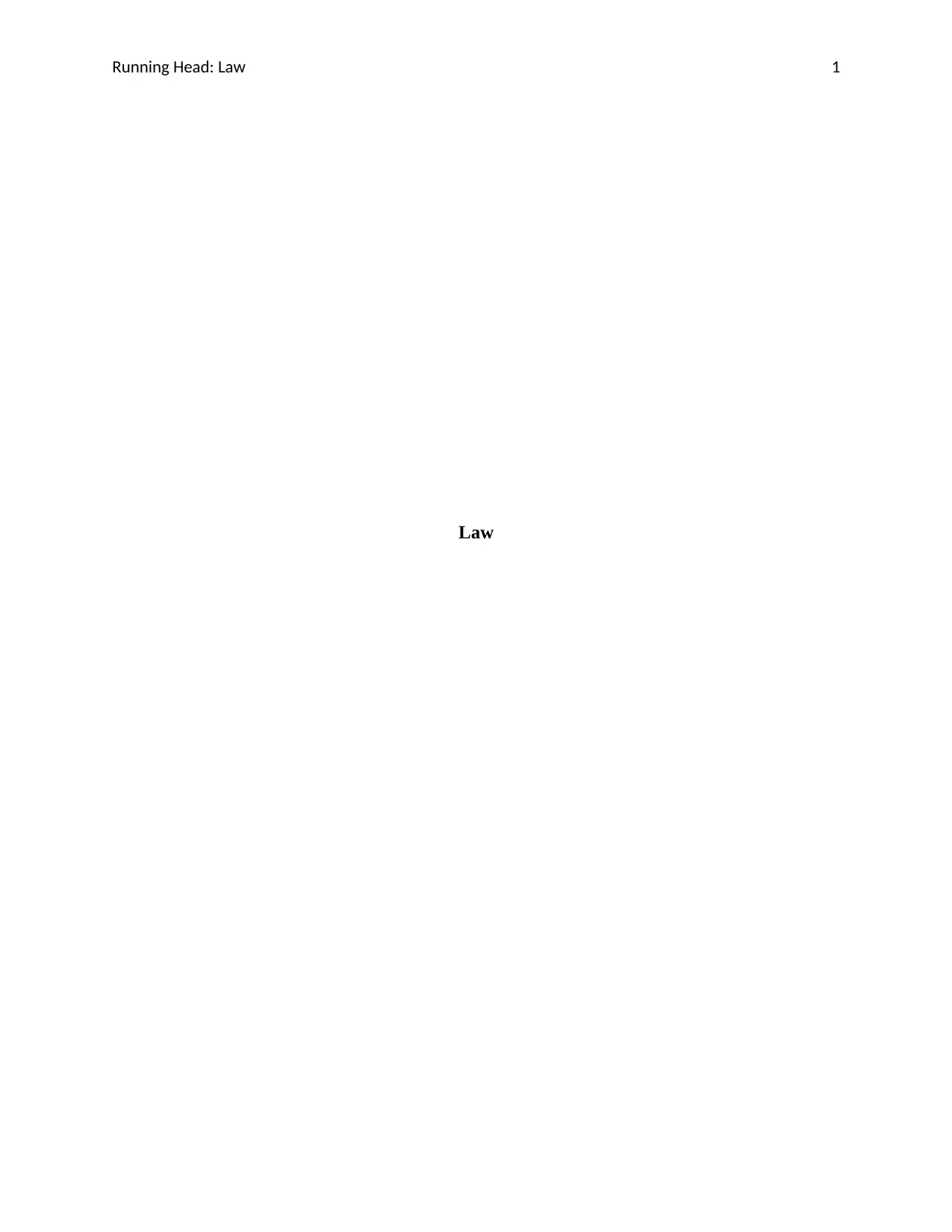
Running Head: Law 1
Law
Law
Paraphrase This Document
Need a fresh take? Get an instant paraphrase of this document with our AI Paraphraser
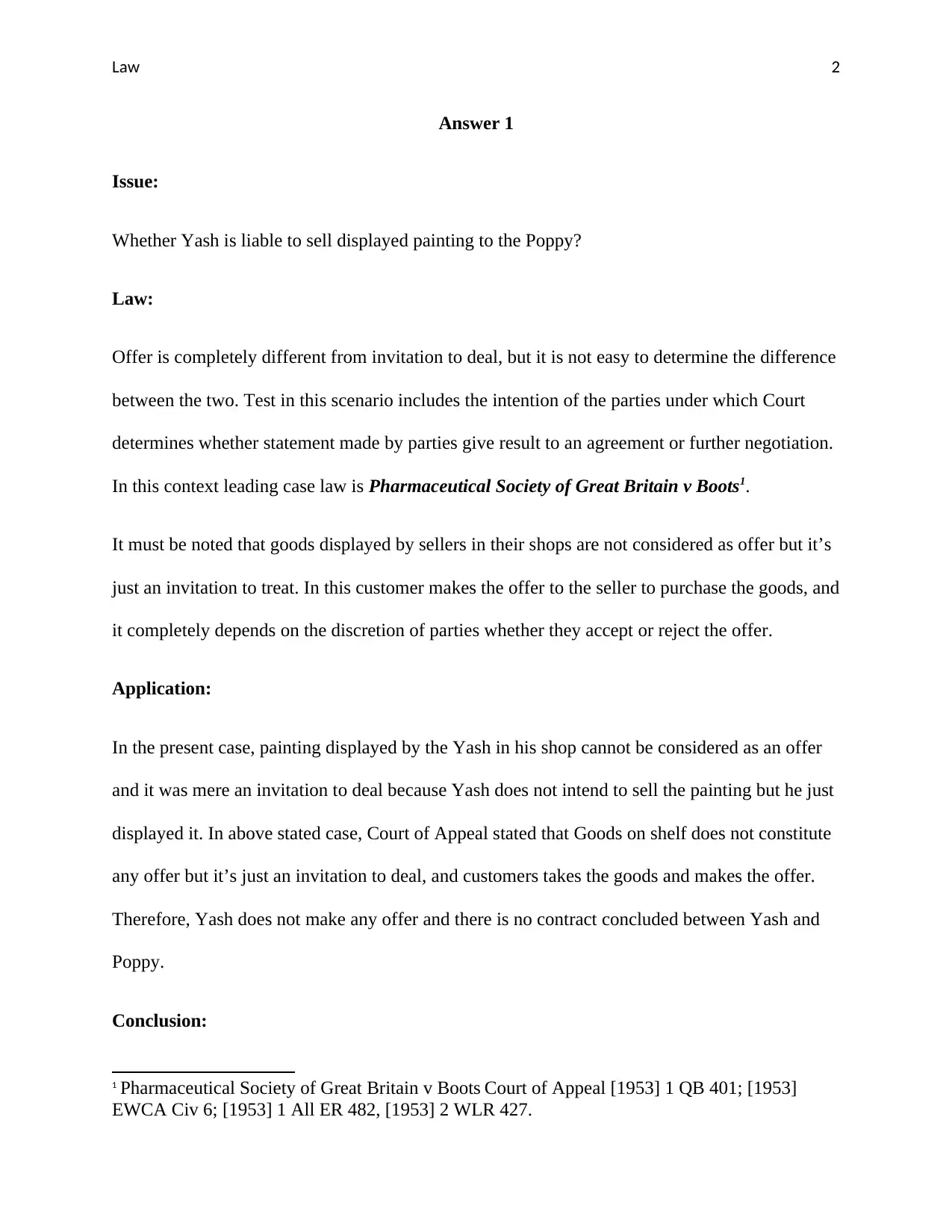
Law 2
Answer 1
Issue:
Whether Yash is liable to sell displayed painting to the Poppy?
Law:
Offer is completely different from invitation to deal, but it is not easy to determine the difference
between the two. Test in this scenario includes the intention of the parties under which Court
determines whether statement made by parties give result to an agreement or further negotiation.
In this context leading case law is Pharmaceutical Society of Great Britain v Boots1.
It must be noted that goods displayed by sellers in their shops are not considered as offer but it’s
just an invitation to treat. In this customer makes the offer to the seller to purchase the goods, and
it completely depends on the discretion of parties whether they accept or reject the offer.
Application:
In the present case, painting displayed by the Yash in his shop cannot be considered as an offer
and it was mere an invitation to deal because Yash does not intend to sell the painting but he just
displayed it. In above stated case, Court of Appeal stated that Goods on shelf does not constitute
any offer but it’s just an invitation to deal, and customers takes the goods and makes the offer.
Therefore, Yash does not make any offer and there is no contract concluded between Yash and
Poppy.
Conclusion:
1 Pharmaceutical Society of Great Britain v Boots Court of Appeal [1953] 1 QB 401; [1953]
EWCA Civ 6; [1953] 1 All ER 482, [1953] 2 WLR 427.
Answer 1
Issue:
Whether Yash is liable to sell displayed painting to the Poppy?
Law:
Offer is completely different from invitation to deal, but it is not easy to determine the difference
between the two. Test in this scenario includes the intention of the parties under which Court
determines whether statement made by parties give result to an agreement or further negotiation.
In this context leading case law is Pharmaceutical Society of Great Britain v Boots1.
It must be noted that goods displayed by sellers in their shops are not considered as offer but it’s
just an invitation to treat. In this customer makes the offer to the seller to purchase the goods, and
it completely depends on the discretion of parties whether they accept or reject the offer.
Application:
In the present case, painting displayed by the Yash in his shop cannot be considered as an offer
and it was mere an invitation to deal because Yash does not intend to sell the painting but he just
displayed it. In above stated case, Court of Appeal stated that Goods on shelf does not constitute
any offer but it’s just an invitation to deal, and customers takes the goods and makes the offer.
Therefore, Yash does not make any offer and there is no contract concluded between Yash and
Poppy.
Conclusion:
1 Pharmaceutical Society of Great Britain v Boots Court of Appeal [1953] 1 QB 401; [1953]
EWCA Civ 6; [1953] 1 All ER 482, [1953] 2 WLR 427.
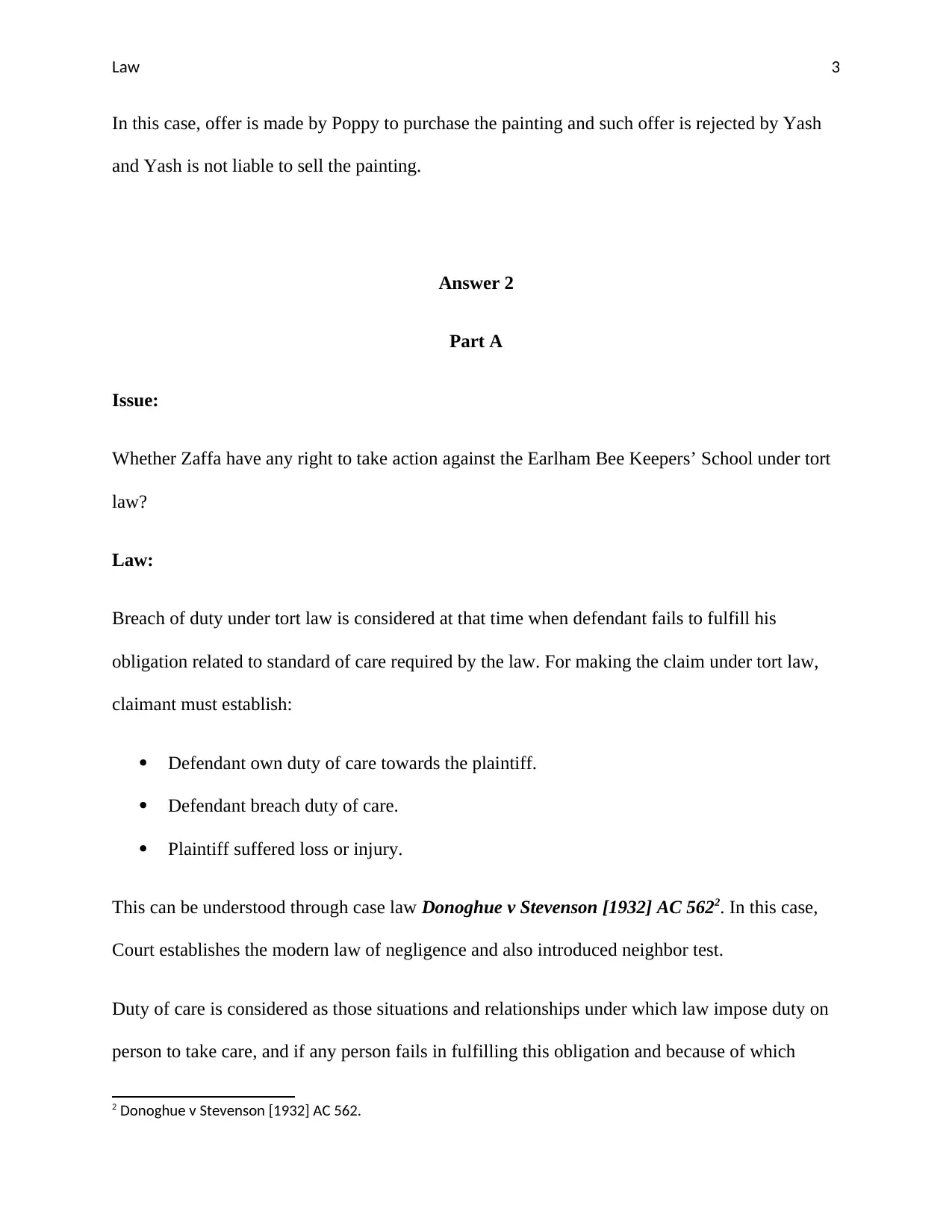
Law 3
In this case, offer is made by Poppy to purchase the painting and such offer is rejected by Yash
and Yash is not liable to sell the painting.
Answer 2
Part A
Issue:
Whether Zaffa have any right to take action against the Earlham Bee Keepers’ School under tort
law?
Law:
Breach of duty under tort law is considered at that time when defendant fails to fulfill his
obligation related to standard of care required by the law. For making the claim under tort law,
claimant must establish:
Defendant own duty of care towards the plaintiff.
Defendant breach duty of care.
Plaintiff suffered loss or injury.
This can be understood through case law Donoghue v Stevenson [1932] AC 5622. In this case,
Court establishes the modern law of negligence and also introduced neighbor test.
Duty of care is considered as those situations and relationships under which law impose duty on
person to take care, and if any person fails in fulfilling this obligation and because of which
2 Donoghue v Stevenson [1932] AC 562.
In this case, offer is made by Poppy to purchase the painting and such offer is rejected by Yash
and Yash is not liable to sell the painting.
Answer 2
Part A
Issue:
Whether Zaffa have any right to take action against the Earlham Bee Keepers’ School under tort
law?
Law:
Breach of duty under tort law is considered at that time when defendant fails to fulfill his
obligation related to standard of care required by the law. For making the claim under tort law,
claimant must establish:
Defendant own duty of care towards the plaintiff.
Defendant breach duty of care.
Plaintiff suffered loss or injury.
This can be understood through case law Donoghue v Stevenson [1932] AC 5622. In this case,
Court establishes the modern law of negligence and also introduced neighbor test.
Duty of care is considered as those situations and relationships under which law impose duty on
person to take care, and if any person fails in fulfilling this obligation and because of which
2 Donoghue v Stevenson [1932] AC 562.
⊘ This is a preview!⊘
Do you want full access?
Subscribe today to unlock all pages.

Trusted by 1+ million students worldwide
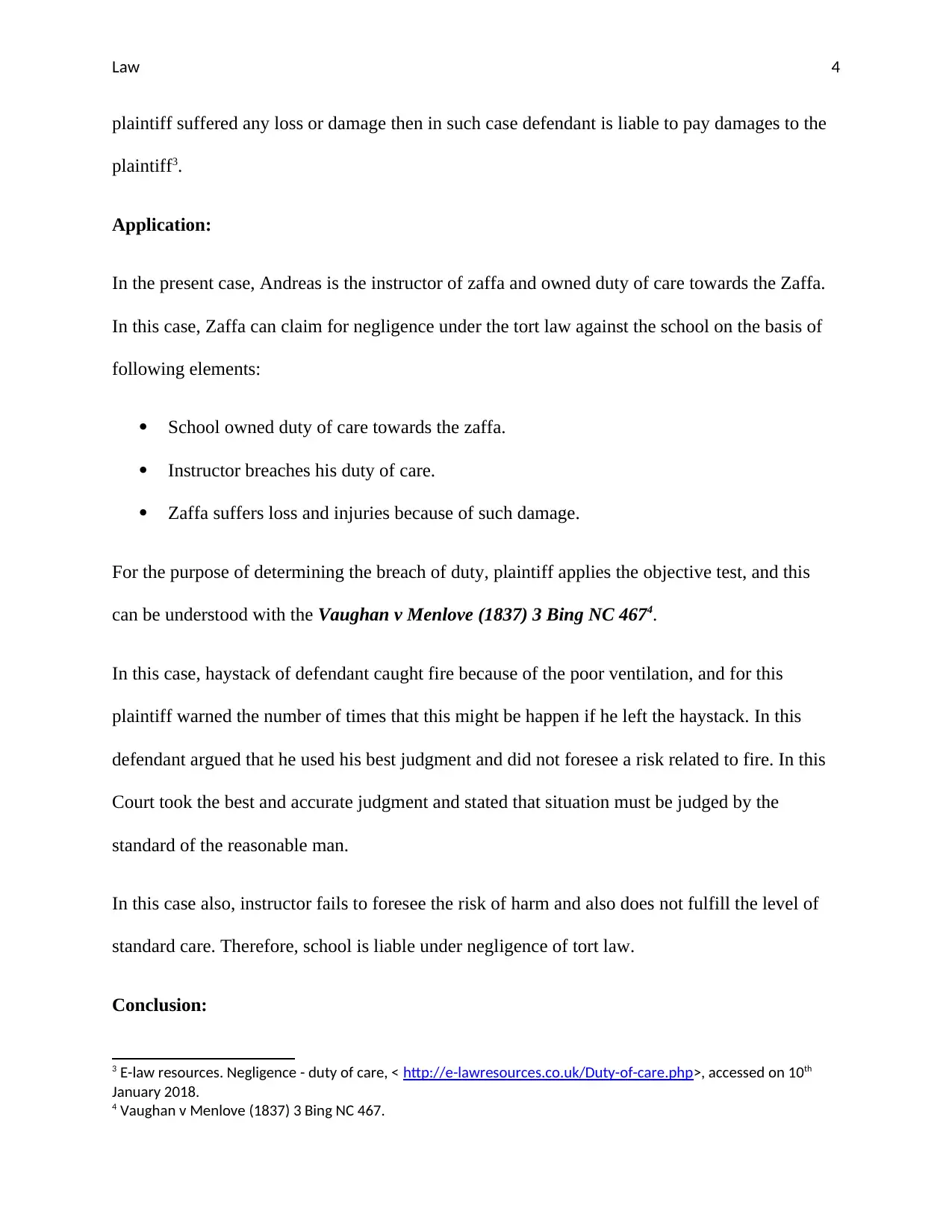
Law 4
plaintiff suffered any loss or damage then in such case defendant is liable to pay damages to the
plaintiff3.
Application:
In the present case, Andreas is the instructor of zaffa and owned duty of care towards the Zaffa.
In this case, Zaffa can claim for negligence under the tort law against the school on the basis of
following elements:
School owned duty of care towards the zaffa.
Instructor breaches his duty of care.
Zaffa suffers loss and injuries because of such damage.
For the purpose of determining the breach of duty, plaintiff applies the objective test, and this
can be understood with the Vaughan v Menlove (1837) 3 Bing NC 4674.
In this case, haystack of defendant caught fire because of the poor ventilation, and for this
plaintiff warned the number of times that this might be happen if he left the haystack. In this
defendant argued that he used his best judgment and did not foresee a risk related to fire. In this
Court took the best and accurate judgment and stated that situation must be judged by the
standard of the reasonable man.
In this case also, instructor fails to foresee the risk of harm and also does not fulfill the level of
standard care. Therefore, school is liable under negligence of tort law.
Conclusion:
3 E-law resources. Negligence - duty of care, < http://e-lawresources.co.uk/Duty-of-care.php>, accessed on 10th
January 2018.
4 Vaughan v Menlove (1837) 3 Bing NC 467.
plaintiff suffered any loss or damage then in such case defendant is liable to pay damages to the
plaintiff3.
Application:
In the present case, Andreas is the instructor of zaffa and owned duty of care towards the Zaffa.
In this case, Zaffa can claim for negligence under the tort law against the school on the basis of
following elements:
School owned duty of care towards the zaffa.
Instructor breaches his duty of care.
Zaffa suffers loss and injuries because of such damage.
For the purpose of determining the breach of duty, plaintiff applies the objective test, and this
can be understood with the Vaughan v Menlove (1837) 3 Bing NC 4674.
In this case, haystack of defendant caught fire because of the poor ventilation, and for this
plaintiff warned the number of times that this might be happen if he left the haystack. In this
defendant argued that he used his best judgment and did not foresee a risk related to fire. In this
Court took the best and accurate judgment and stated that situation must be judged by the
standard of the reasonable man.
In this case also, instructor fails to foresee the risk of harm and also does not fulfill the level of
standard care. Therefore, school is liable under negligence of tort law.
Conclusion:
3 E-law resources. Negligence - duty of care, < http://e-lawresources.co.uk/Duty-of-care.php>, accessed on 10th
January 2018.
4 Vaughan v Menlove (1837) 3 Bing NC 467.
Paraphrase This Document
Need a fresh take? Get an instant paraphrase of this document with our AI Paraphraser
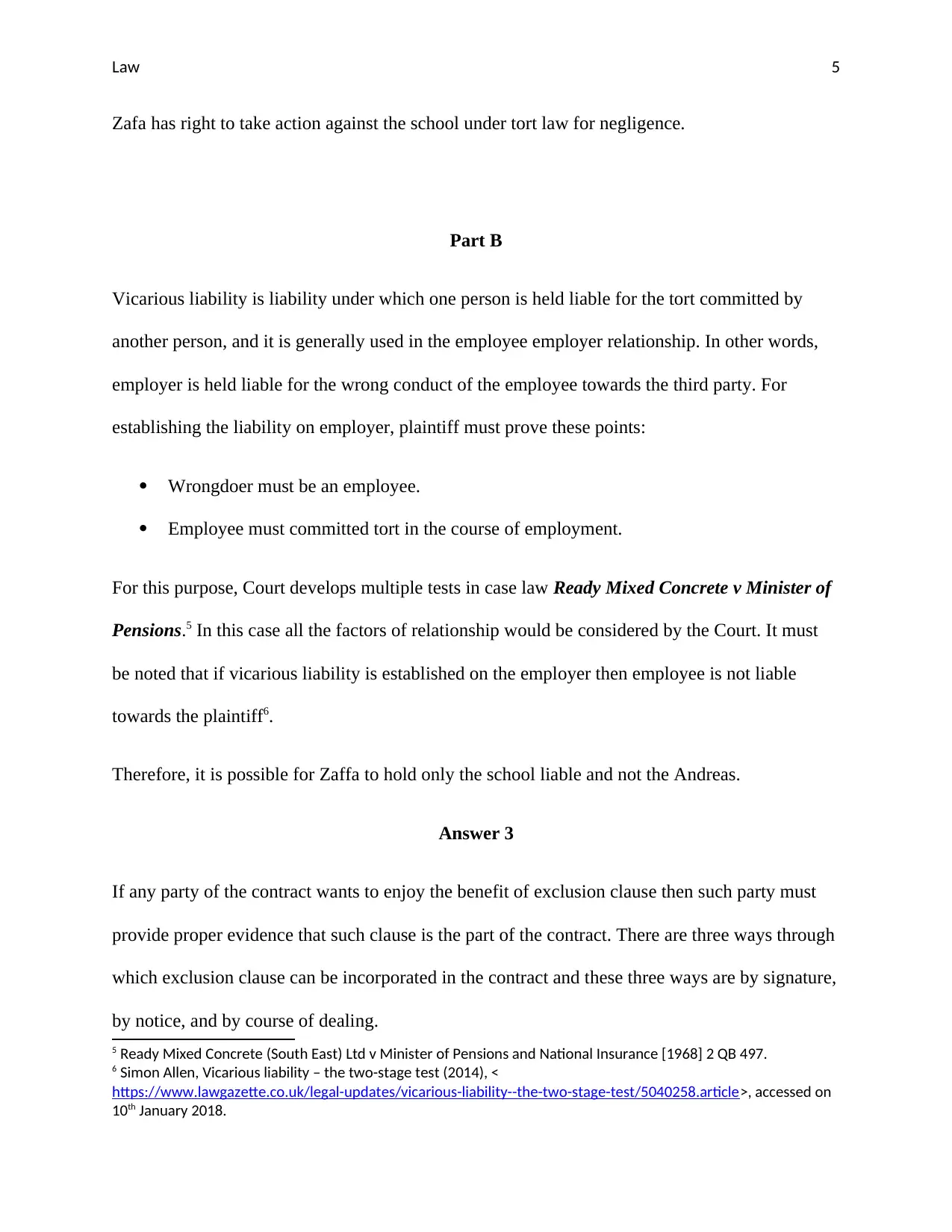
Law 5
Zafa has right to take action against the school under tort law for negligence.
Part B
Vicarious liability is liability under which one person is held liable for the tort committed by
another person, and it is generally used in the employee employer relationship. In other words,
employer is held liable for the wrong conduct of the employee towards the third party. For
establishing the liability on employer, plaintiff must prove these points:
Wrongdoer must be an employee.
Employee must committed tort in the course of employment.
For this purpose, Court develops multiple tests in case law Ready Mixed Concrete v Minister of
Pensions.5 In this case all the factors of relationship would be considered by the Court. It must
be noted that if vicarious liability is established on the employer then employee is not liable
towards the plaintiff6.
Therefore, it is possible for Zaffa to hold only the school liable and not the Andreas.
Answer 3
If any party of the contract wants to enjoy the benefit of exclusion clause then such party must
provide proper evidence that such clause is the part of the contract. There are three ways through
which exclusion clause can be incorporated in the contract and these three ways are by signature,
by notice, and by course of dealing.
5 Ready Mixed Concrete (South East) Ltd v Minister of Pensions and National Insurance [1968] 2 QB 497.
6 Simon Allen, Vicarious liability – the two-stage test (2014), <
https://www.lawgazette.co.uk/legal-updates/vicarious-liability--the-two-stage-test/5040258.article>, accessed on
10th January 2018.
Zafa has right to take action against the school under tort law for negligence.
Part B
Vicarious liability is liability under which one person is held liable for the tort committed by
another person, and it is generally used in the employee employer relationship. In other words,
employer is held liable for the wrong conduct of the employee towards the third party. For
establishing the liability on employer, plaintiff must prove these points:
Wrongdoer must be an employee.
Employee must committed tort in the course of employment.
For this purpose, Court develops multiple tests in case law Ready Mixed Concrete v Minister of
Pensions.5 In this case all the factors of relationship would be considered by the Court. It must
be noted that if vicarious liability is established on the employer then employee is not liable
towards the plaintiff6.
Therefore, it is possible for Zaffa to hold only the school liable and not the Andreas.
Answer 3
If any party of the contract wants to enjoy the benefit of exclusion clause then such party must
provide proper evidence that such clause is the part of the contract. There are three ways through
which exclusion clause can be incorporated in the contract and these three ways are by signature,
by notice, and by course of dealing.
5 Ready Mixed Concrete (South East) Ltd v Minister of Pensions and National Insurance [1968] 2 QB 497.
6 Simon Allen, Vicarious liability – the two-stage test (2014), <
https://www.lawgazette.co.uk/legal-updates/vicarious-liability--the-two-stage-test/5040258.article>, accessed on
10th January 2018.
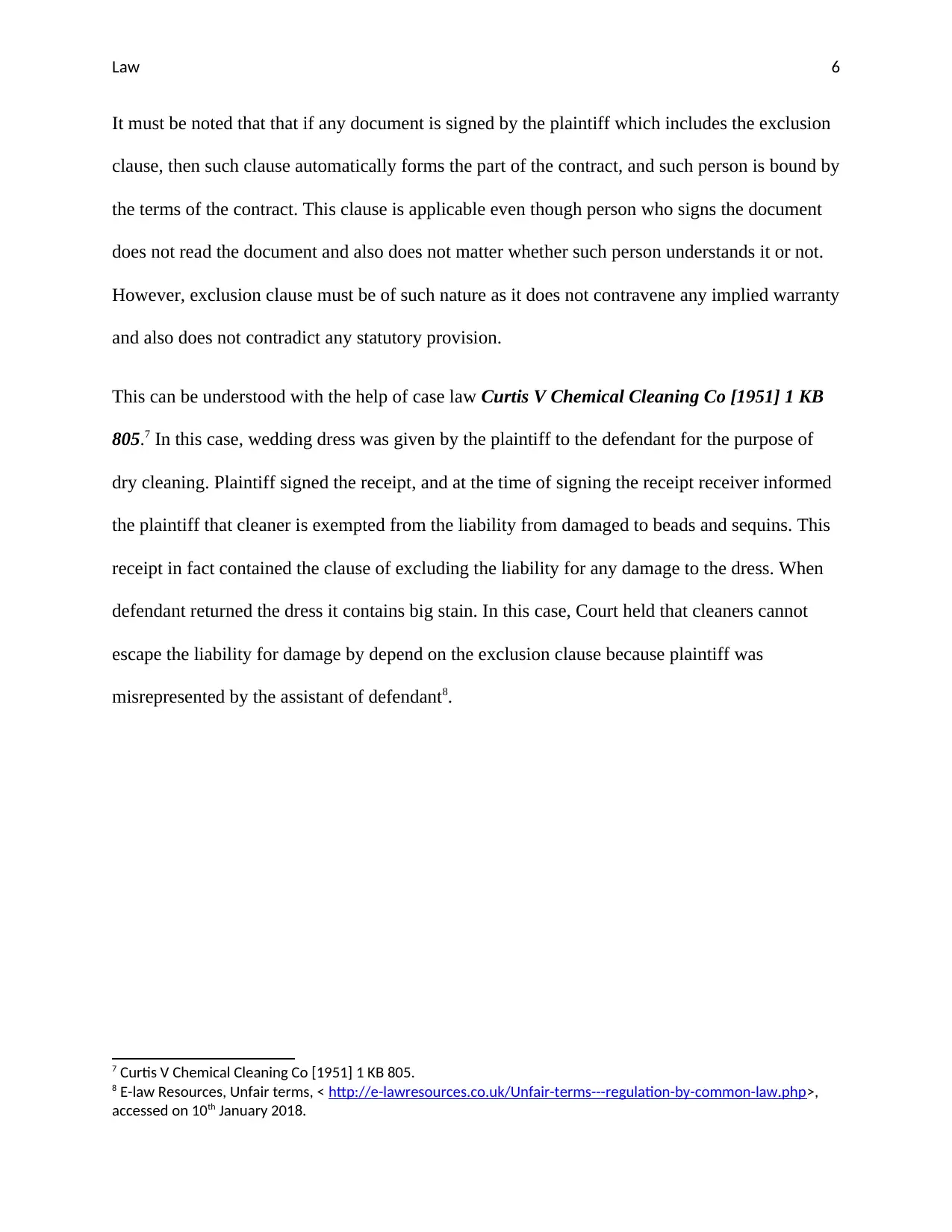
Law 6
It must be noted that that if any document is signed by the plaintiff which includes the exclusion
clause, then such clause automatically forms the part of the contract, and such person is bound by
the terms of the contract. This clause is applicable even though person who signs the document
does not read the document and also does not matter whether such person understands it or not.
However, exclusion clause must be of such nature as it does not contravene any implied warranty
and also does not contradict any statutory provision.
This can be understood with the help of case law Curtis V Chemical Cleaning Co [1951] 1 KB
805.7 In this case, wedding dress was given by the plaintiff to the defendant for the purpose of
dry cleaning. Plaintiff signed the receipt, and at the time of signing the receipt receiver informed
the plaintiff that cleaner is exempted from the liability from damaged to beads and sequins. This
receipt in fact contained the clause of excluding the liability for any damage to the dress. When
defendant returned the dress it contains big stain. In this case, Court held that cleaners cannot
escape the liability for damage by depend on the exclusion clause because plaintiff was
misrepresented by the assistant of defendant8.
7 Curtis V Chemical Cleaning Co [1951] 1 KB 805.
8 E-law Resources, Unfair terms, < http://e-lawresources.co.uk/Unfair-terms---regulation-by-common-law.php>,
accessed on 10th January 2018.
It must be noted that that if any document is signed by the plaintiff which includes the exclusion
clause, then such clause automatically forms the part of the contract, and such person is bound by
the terms of the contract. This clause is applicable even though person who signs the document
does not read the document and also does not matter whether such person understands it or not.
However, exclusion clause must be of such nature as it does not contravene any implied warranty
and also does not contradict any statutory provision.
This can be understood with the help of case law Curtis V Chemical Cleaning Co [1951] 1 KB
805.7 In this case, wedding dress was given by the plaintiff to the defendant for the purpose of
dry cleaning. Plaintiff signed the receipt, and at the time of signing the receipt receiver informed
the plaintiff that cleaner is exempted from the liability from damaged to beads and sequins. This
receipt in fact contained the clause of excluding the liability for any damage to the dress. When
defendant returned the dress it contains big stain. In this case, Court held that cleaners cannot
escape the liability for damage by depend on the exclusion clause because plaintiff was
misrepresented by the assistant of defendant8.
7 Curtis V Chemical Cleaning Co [1951] 1 KB 805.
8 E-law Resources, Unfair terms, < http://e-lawresources.co.uk/Unfair-terms---regulation-by-common-law.php>,
accessed on 10th January 2018.
⊘ This is a preview!⊘
Do you want full access?
Subscribe today to unlock all pages.

Trusted by 1+ million students worldwide
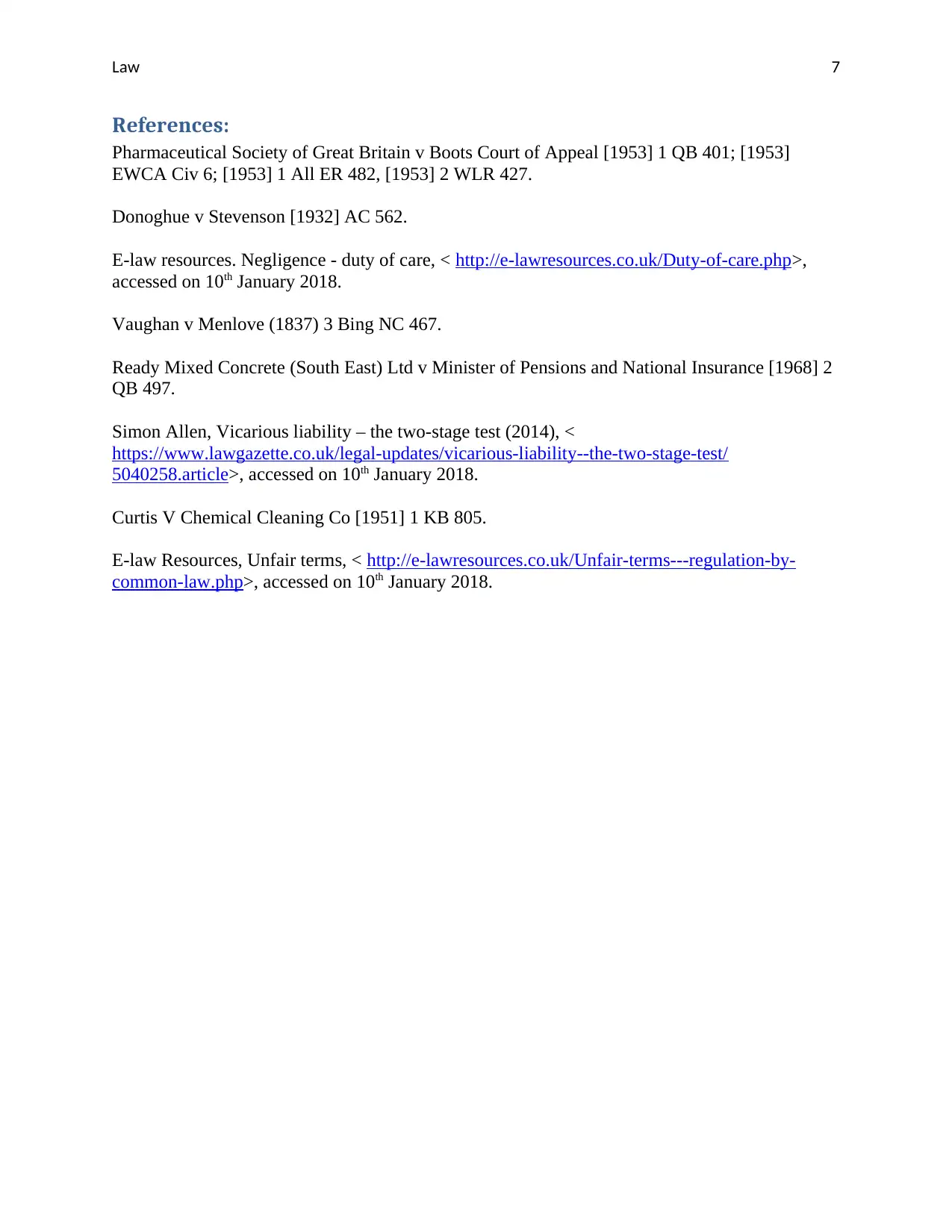
Law 7
References:
Pharmaceutical Society of Great Britain v Boots Court of Appeal [1953] 1 QB 401; [1953]
EWCA Civ 6; [1953] 1 All ER 482, [1953] 2 WLR 427.
Donoghue v Stevenson [1932] AC 562.
E-law resources. Negligence - duty of care, < http://e-lawresources.co.uk/Duty-of-care.php>,
accessed on 10th January 2018.
Vaughan v Menlove (1837) 3 Bing NC 467.
Ready Mixed Concrete (South East) Ltd v Minister of Pensions and National Insurance [1968] 2
QB 497.
Simon Allen, Vicarious liability – the two-stage test (2014), <
https://www.lawgazette.co.uk/legal-updates/vicarious-liability--the-two-stage-test/
5040258.article>, accessed on 10th January 2018.
Curtis V Chemical Cleaning Co [1951] 1 KB 805.
E-law Resources, Unfair terms, < http://e-lawresources.co.uk/Unfair-terms---regulation-by-
common-law.php>, accessed on 10th January 2018.
References:
Pharmaceutical Society of Great Britain v Boots Court of Appeal [1953] 1 QB 401; [1953]
EWCA Civ 6; [1953] 1 All ER 482, [1953] 2 WLR 427.
Donoghue v Stevenson [1932] AC 562.
E-law resources. Negligence - duty of care, < http://e-lawresources.co.uk/Duty-of-care.php>,
accessed on 10th January 2018.
Vaughan v Menlove (1837) 3 Bing NC 467.
Ready Mixed Concrete (South East) Ltd v Minister of Pensions and National Insurance [1968] 2
QB 497.
Simon Allen, Vicarious liability – the two-stage test (2014), <
https://www.lawgazette.co.uk/legal-updates/vicarious-liability--the-two-stage-test/
5040258.article>, accessed on 10th January 2018.
Curtis V Chemical Cleaning Co [1951] 1 KB 805.
E-law Resources, Unfair terms, < http://e-lawresources.co.uk/Unfair-terms---regulation-by-
common-law.php>, accessed on 10th January 2018.
1 out of 7
Related Documents
Your All-in-One AI-Powered Toolkit for Academic Success.
+13062052269
info@desklib.com
Available 24*7 on WhatsApp / Email
![[object Object]](/_next/static/media/star-bottom.7253800d.svg)
Unlock your academic potential
Copyright © 2020–2025 A2Z Services. All Rights Reserved. Developed and managed by ZUCOL.





